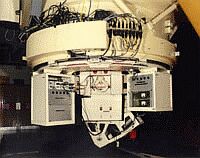First light (at ING): March 1984 (decommissioned on 17 July 2003, recommissioned on 1 August 2006).
De-commissioned: 17th June 2024
Designed and built by: RGO
Description: The principal common-user instrument
at the Cassegrain focus of the INT is the Intermediate Dispersion Spectrograph
(IDS), with a choice of two cameras of different focal lengths. It is combined
with the Faint Object Spectrograph (FOS), a fixed-format, efficient spectrograph
designed for low resolution work.
Both the IDS and the FOS are part
of the same structure: a folded-input, flat-bed instrument, with the FOS
occupying the straight through position. The spectrographs hang below
an Acquisition and Guidance unit. Both cameras of the IDS (and indeed the
FOS) may be used during the same night. Facilities for acquisition and
guidance, calibration and comparison lamps, neutral-density and colour
filters are located in the A&G unit to which the spectrograph is attached.
Spectrograph and A&G functions are computer-controlled, although changes
of grating and collimator are manual.
The IDS has a wide selection of
first-order gratings giving dispersions in the range 7-140 Å/mm.
Two cameras have focal lengths of 235 and 500 mm.
In June 1988, a square-to-line reformatter (SQRIL) was tested and
commissioned. Mounted in the multislit unit, it consists of an array of 100
fibres changing a 12 × 12 arcsecond grid to a line feeding an input
slit to the IDS.
Time allocations:
Nights scheduled since semester 2007B
Instrument information: http://www.ing.iac.es/Astronomy/instruments/ids/
Research impact:
Scientific highlights (31)
Outreach:
Media releases (14)
Multimedia:
Photo archive (7)
Video archive (4)



